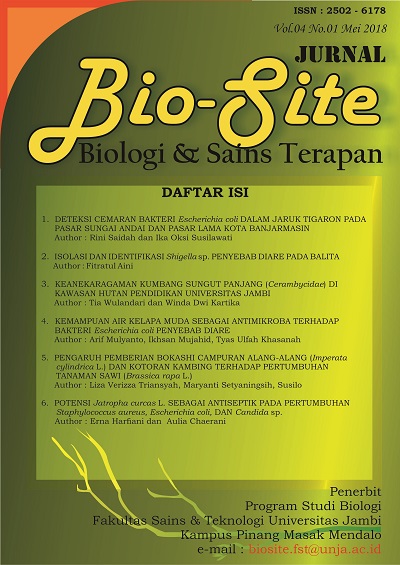Deteksi Cemaran Bakteri Escherichia coli dalam Jaruk Tigaron pada Pasar Sungai Andai dan Pasar Lama Kota Banjarmasin
DOI:
https://doi.org/10.22437/bs.v4i1.4927Keywords:
Jaruk Tigaron, Escherichia coli, Most Probable Number, MPNAbstract
Jaruk tigaron is one of the traditional fermented foods originating from South Kalimantan made by fermented tigaron flowers (Crataeva nurvala, Buch HAM). The process of making traditionally allows contamination by the bacteria Eschericia coli (E.coli). Escherichia coli is the most commonly used a microbe as an indicator of faecal contamination in water, even food or beverages, including various types of jaruk. This final project aims to detect Escherichia coli on jaruk tigaron thatdistributed in Banjarmasin. The method was used in detecting Escherichia coli is the Most Probable Number (MPN) with five test stages are estimation test, confirmatory test, complementary test, biochemical test (TSIA and IMVIC). The media was used is a Lactose Broth Single Strength (LBSS) by 3 series for forecasting test, Brilliant Green Bile Broth (BGLB) media for confirmatory test, Eosin Methylene Blue Agar (EMBA) media for complementary test, TSIA test and IMVIC test. The test results was obtained by MPN index on samples (a) 28 samples (b)> 1.100 and sample (c) 20. The detection results is Escherichia coli on jaruk tigaron thatdistributed in Banjarmasin declared negatively containing Escherichia coli but only contain Coliform bacteria. Based on SNI 7388: 2009, the determination of the maximum limit of microbial contamination in food is the absence of Coliform and Escherichia coli bacteria in 100 ml of sample
Downloads
References
2. Badan POM RI. 2008. InfoPOM Badan Pengawas Obat dan Makanan Republik Indonesia. Vol. 9. No. 2. Maret. ISSN 1829-9334.
3. Badan Standardisasi Nasional. 2009. Batas Maksimum Cemaran Mikroba dalam Pangan. SNI 7388:2009.
Dwidjoseputro. 1994. Dasar-Dasar Mikrobiologi. Djambatan. Jakarta.
4. Falamy, R. S. Warganegara & E. Apriliana. 2012. Deteksi Cemaran Coliform pada Jajanan Pasar Cincau Hitam di Pasar Tradisional dan Swalayan Kota Bandar Lampung. MAJORITY. ISSN 2337-3776 : 1-9.
5. Hapip, A.D. 2008. Kamus Banjar Indonesia. Cetakan ke VI. Rahmat Hafiz Al Mubaraq. Banjarmasin.
6. Handayani, B.R. & W. Werdiningsih. 2010. Kondisi Sanitasi dan Keracuan Makanan Tradisional. Agroteksos.20(2-3) : 131-138.
7. Purnawijayanti, H. A. 2001. Sanitasi Higiene dan Keselamatan Kerja Dalam Pengolahan Makanan. Yogyakarta : Kanisius.
8. Sari R., P. Apridamayanti. 2104. Cemaran Bakteri Eschericia Coli dalam Beberapa Makanan Laut yang Beredar di Pasar Tradisional Kota Pontianak. Kartika Jurnal Ilmiah Farmasi, ISSN 2354-6565.
9. Suriawiria U. 2003. Mikrobiologi Air dan Dasar-Dasar Pengolahan Secara Biologis. ITB, Bandung.
Downloads
Published
Versions
- 2019-01-11 (1)
- 2019-01-11 (1)
How to Cite
Issue
Section
License
This work is licensed under a Creative Commons Attribution 4.0 International License.
Copyright Notice:
1. Authors retain copyright and grant the journal right of first publication with the work simultaneously licensed under a Creative Commons Attribution 4.0 International License that allows others to share the work with an acknowledgement of the work's authorship and initial publication in this journal.
2. Authors are able to enter into separate, additional contractual arrangements for the non-exclusive distribution of the journal's published version of the work (e.g., post it to an institutional repository or publish it in a book), with an acknowledgement of its initial publication in this journal.
3. Authors are permitted and encouraged to post their work online (e.g., in institutional repositories or on their website) prior to and during the submission process, as it can lead to productive exchanges, as well as earlier and greater citation of published work (The Effect of Open Access)






